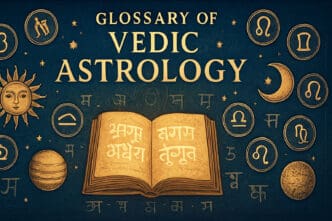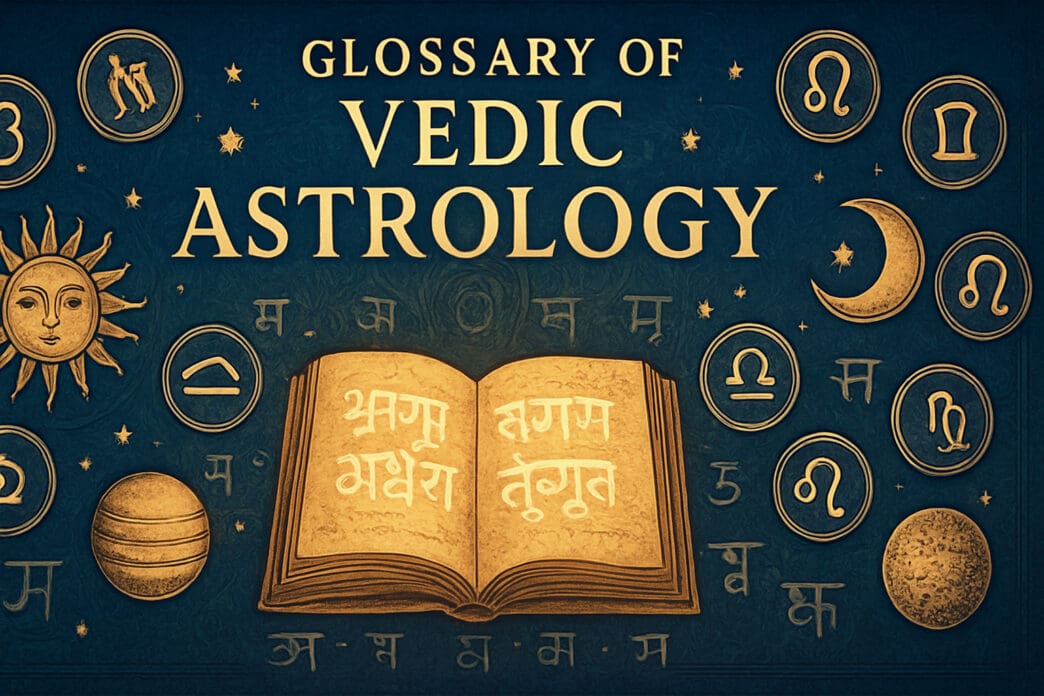Vedic Astrology, known in Sanskrit as Jyotish or the “science of light,” offers a profound language for understanding the intricate tapestry of human life. For anyone seeking to decode their cosmic DNA, this ancient Indian system provides a map based on the precise planetary alignments at the moment of birth. This map, or natal chart, uses a specific lexicon—including Grahas (planets), Rashis (zodiac signs), and Bhavas (houses)—to reveal an individual’s karmic blueprint, inherent personality, life’s challenges, and ultimate purpose. Understanding these essential terms is the first and most critical step in harnessing this powerful tool for self-awareness and navigating your life’s path with greater clarity and intention.
The Foundations of Jyotish
Before diving into the specific components of a chart, it’s crucial to grasp the philosophical bedrock upon which Vedic Astrology is built. It is not merely a predictive tool but a system designed to illuminate one’s journey through life.
Jyotish: The Science of Light
The term Jyotish is a combination of two Sanskrit words: “Jyoti,” meaning light, and “Isha,” meaning lord or God. Therefore, Jyotish is the “light of the divine” or the “knowledge of light.” Its purpose is to shine a light on the hidden forces and karmic patterns that shape our experiences, removing the darkness of ignorance and empowering us with understanding.
Karma and the Natal Chart
At the heart of Jyotish lies the law of karma, the principle of cause and effect. A Vedic birth chart is considered a snapshot of your “prarabdha karma”—the portion of your past karmas that has become ripe and is destined to unfold in this lifetime. The planets don’t cause good or bad fortune; they are simply cosmic messengers delivering the results of our own past actions.
Dharma: Your Soul’s Purpose
The chart is also a guide to understanding your Dharma, or your unique, righteous path in life. By analyzing the strengths and weaknesses of the planets and houses, an astrologer can identify your innate talents, duties, and the areas of life where you are meant to contribute. Living in alignment with your Dharma is considered a key to fulfillment and spiritual growth.
The Nine Grahas: The Celestial Influencers
In Vedic Astrology, the term for a planet is “Graha,” which translates to “that which seizes” or “grasps.” This implies that the Grahas are powerful celestial forces that seize our consciousness and influence our behavior and the events in our lives. There are nine primary Grahas.
The Seven Classical Grahas
These are the seven visible celestial bodies that have been observed for millennia.
Surya (The Sun): The Sun represents the soul, the ego, vitality, and our sense of self. It is the king of the solar system and signifies authority, power, leadership, and the father figure.
Chandra (The Moon): The Moon governs the mind, emotions, feelings, and our capacity for nurturing. It represents the mother, the public, our inner peace, and how we emotionally respond to the world.
Mangal (Mars): Mars is the planet of energy, action, courage, and initiative. It represents our drive, ambition, siblings (especially brothers), and can also indicate conflict, aggression, and accidents when afflicted.
Budha (Mercury): Mercury is the prince of the planetary cabinet, governing intellect, communication, speech, logic, and commerce. It is an adaptable planet that reflects the qualities of the planets it is associated with.
Guru (Jupiter): Known as the great benefic, Jupiter represents wisdom, knowledge, expansion, and fortune. It is the divine teacher (guru), signifying higher learning, philosophy, children, and wealth.
Shukra (Venus): Venus is the other benefic planet, governing love, beauty, romance, art, luxury, and pleasure. It represents our relationships, spouse, comfort, and the capacity to appreciate the finer things in life.
Shani (Saturn): Saturn is the great taskmaster and lord of karma. It represents discipline, structure, responsibility, and the reality of time. While often feared, Saturn brings maturity, perseverance, and long-lasting success through hard work and patience.
The Shadow Planets: Rahu and Ketu
Rahu and Ketu are not physical bodies but are mathematically calculated points where the path of the Moon intersects the ecliptic (the path of the Sun). They are the North and South lunar nodes, respectively, and hold immense karmic significance.
Rahu (North Node): Rahu is a force of worldly desire, ambition, and obsession. It represents the areas in life we are meant to explore and develop in this incarnation. It can bring sudden fame and wealth but also deals with illusion, addiction, and foreign influences.
Ketu (South Node): Ketu is the opposite of Rahu, representing detachment, spirituality, and past-life mastery. It signifies areas where we have already achieved proficiency and now must let go. Ketu can bring profound spiritual insights but also confusion, loss, and a sense of dissatisfaction with the material world.
The Twelve Rashis: The Cosmic Backdrop
The zodiac in Vedic Astrology is comprised of twelve Rashis, or signs. Unlike Western astrology which uses the Tropical Zodiac tied to the seasons, Jyotish uses the Sidereal Zodiac. The Sidereal system is aligned with the fixed constellations, accounting for the precession of the equinoxes through a correction called the “Ayanamsha.” This results in the zodiac placement of your planets being about 24 degrees earlier than in a Western chart.
The twelve Rashis are:
- Mesha (Aries)
- Vrishabha (Taurus)
- Mithuna (Gemini)
- Karka (Cancer)
- Simha (Leo)
- Kanya (Virgo)
- Tula (Libra)
- Vrischika (Scorpio)
- Dhanu (Sagittarius)
- Makara (Capricorn)
- Kumbha (Aquarius)
- Meena (Pisces)
The Twelve Bhavas: The Arenas of Life
The twelve Bhavas, or houses, represent the different fields of life where the energies of the planets and signs manifest. The entire zodiac is mapped across these twelve houses, beginning with the Ascendant.
The Lagna: The First House and Your Identity
The most important point in the entire chart is the Lagna, or Ascendant. This is the zodiac sign that was rising on the eastern horizon at your exact time of birth. The Lagna is the first house, representing the self, physical body, personality, health, and overall life path. The planet that rules the Lagna sign becomes your “Lagna Lord” and is a key planet in your chart.
An Overview of the Houses
Each house has a primary domain:
- 1st House: Self, personality, physical body, appearance.
- 2nd House: Wealth, family, speech, food.
- 3rd House: Courage, siblings, communication, short journeys.
- 4th House: Mother, home, vehicles, happiness, emotions.
- 5th House: Children, creativity, intellect, investments, romance.
- 6th House: Health, debts, enemies, daily work, service.
- 7th House: Marriage, spouse, partnerships, business.
- 8th House: Longevity, transformation, inheritance, occult.
- 9th House: Father, fortune, higher education, spirituality, long journeys.
- 10th House: Career, status, public life, karma (action).
- 11th House: Gains, income, friends, hopes and wishes.
- 12th House: Loss, expenses, foreign lands, enlightenment, subconscious.
Timing and Prediction: Dashas and Gochara
A unique feature of Vedic Astrology is its sophisticated systems for timing life events. The promises of the natal chart unfold at specific times, governed by planetary periods and transits.
The Dasha System: Your Planetary Timetable
The most commonly used system is the Vimshottari Dasha, a 120-year cycle of planetary rulership. At birth, you begin a major period (Mahadasha) of a specific planet, which then unfolds through sub-periods (Antardashas) of all nine planets. When you are running the Dasha of a planet, its nature and placement in your chart will color your experiences and bring forth the karmic results it is designated to deliver.
Gochara: The Transits
Gochara refers to the continuous, real-time movement of the planets in the sky. These transits act as triggers. A life event is most likely to occur when the promise exists in the natal chart, the relevant Dasha period is active, and a key planet transits over a sensitive point in the chart, activating the potential.
Key Concepts and Tools
Beyond the basics, several other concepts are vital for a complete astrological analysis.
Yogas: Planetary Combinations
A “Yoga” is a specific combination or placement of planets that produces a particular result. There are thousands of yogas, ranging from Dhana Yogas (indicating wealth) and Raja Yogas (indicating power and status) to yogas that indicate challenges or spiritual tendencies. The presence of strong yogas can significantly elevate a chart’s potential.
Drishti: The Planetary Gaze
Planets do not just influence the house they occupy; they also cast an aspect, or “Drishti” (gaze), onto other houses. All planets aspect the 7th house from their position. However, Mars, Jupiter, and Saturn have special aspects that give them a broader field of influence, making them particularly powerful agents in a chart.
The Navamsa (D9) Chart
Vedic Astrology uses many divisional charts (Vargas) to examine specific areas of life in greater detail. The most important of these is the Navamsa or D9 chart. It is a microscopic view of the 9th harmonic of the main chart and is said to reveal the “fruit” of the life path. It is crucial for assessing the true strength of planets, the nature of one’s spouse and marriage, and the destiny that unfolds in the second half of life.
Upayas: Astrological Remedies
Jyotish is not fatalistic. It offers a path to mitigate difficult karmic patterns and enhance positive ones through “Upayas,” or remedial measures. These can include chanting specific mantras, wearing prescribed gemstones, engaging in charity, performing rituals, or making lifestyle changes that align with the energies of the planets. The goal of an Upaya is to create a conscious and positive relationship with the planetary energies influencing you.
Learning the language of Vedic Astrology is a journey into the self. By understanding these core terms, you begin to see your life not as a series of random events, but as a meaningful cosmic play. This ancient science provides a framework to appreciate your strengths, navigate your challenges, and consciously co-create a life that is in harmony with your soul’s deepest purpose.








